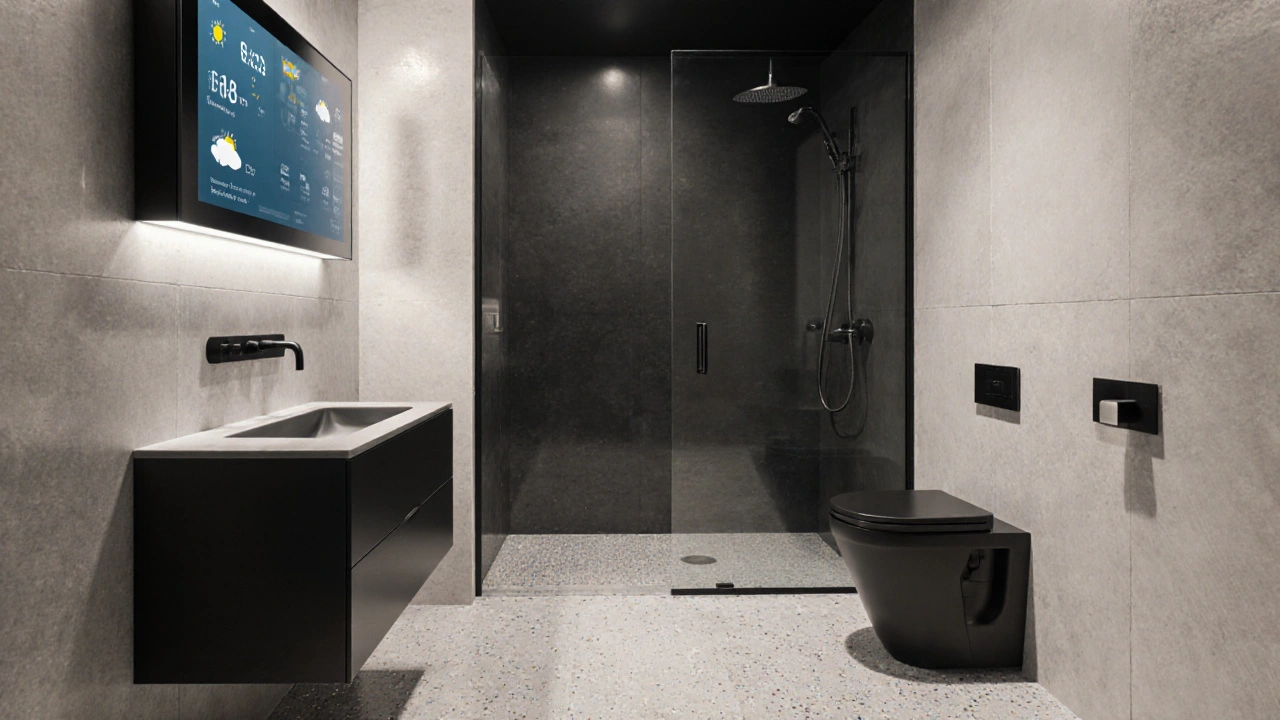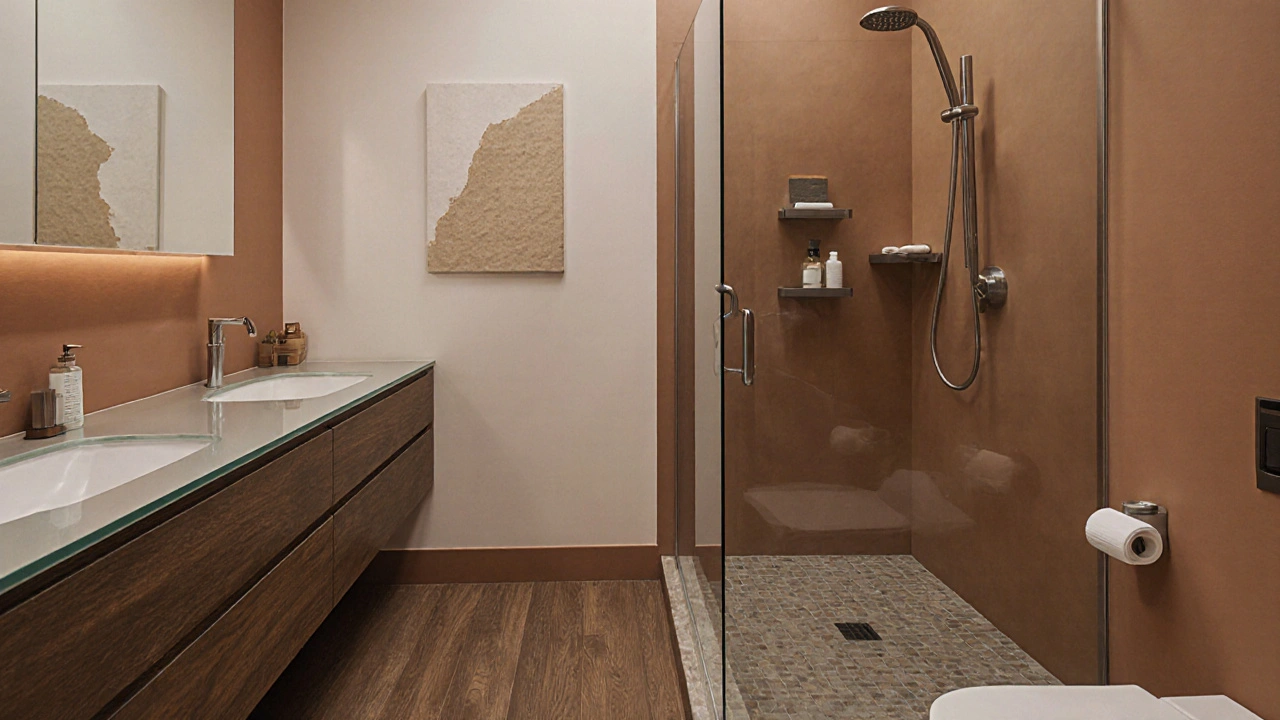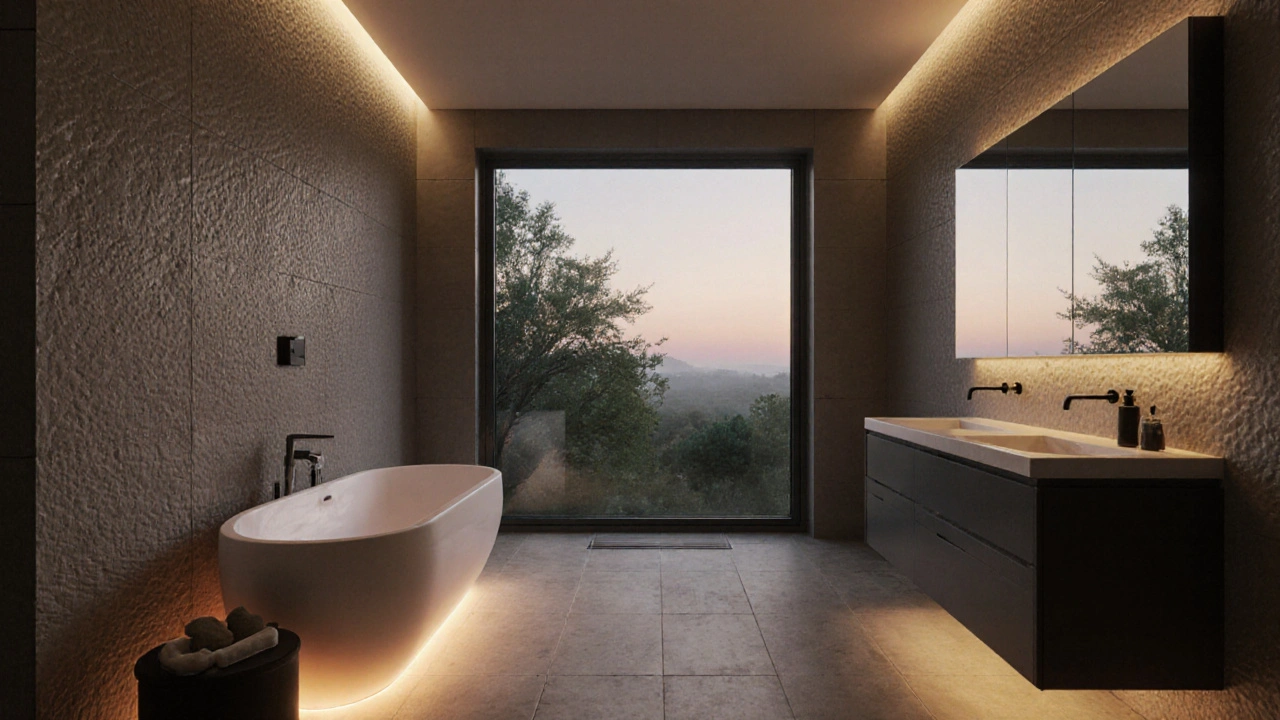By 2025, your bathroom isn’t just a place to wash up-it’s your personal retreat. People aren’t just upgrading fixtures anymore. They’re rethinking the whole space to feel like a spa, a tech hub, and a sustainable sanctuary all at once. If you’re planning a remodel this year, you’re not chasing fads. You’re investing in what actually makes daily life better.
Spa-Like Bathrooms Are the New Standard
Forget the white tile and chrome faucets of the 2010s. Today’s top bathrooms feel like a high-end hotel suite. Deep soaking tubs are back, but not the clawfoot kind. Think built-in, freestanding tubs with integrated LED lighting that shifts from cool blue to warm amber. They’re not just for show-they’re designed for real relaxation. People are installing them right next to windows with privacy glass, so you can soak while watching the trees outside.
Heated floors aren’t a luxury anymore. They’re expected. In colder climates like Burlington, homeowners are choosing radiant floor heating with programmable zones. One zone for the shower area, another for the vanity, and a third for the rest of the floor. It’s not expensive to run-just a few cents a day-and it makes winter mornings feel like a gift.
Textured walls are trending too. Instead of smooth tile, people are using natural stone slabs, hand-glazed ceramic, or even cork panels that absorb sound. The goal? Quiet. Calm. No echo. No glare. Just peace.
Smart Tech That Actually Works
Smart mirrors aren’t just for checking your hair. The best ones in 2025 show weather, calendar alerts, and even your heart rate after a shower-thanks to built-in sensors. Brands like Kohler and Moen now offer mirrors with voice control, anti-fog tech, and Bluetooth speakers that sync with your phone.
But the real game-changer? Smart showers. You can set your perfect water temperature, pressure, and even scent (yes, aromatherapy mist) from your phone before you even step in. Some systems learn your habits-like how long you like to shower on Mondays versus Fridays-and adjust automatically. No more fumbling with dials while your water runs cold.
And don’t forget the toilets. Dual-flush models are standard now, but the new ones have automatic lids, heated seats, and self-cleaning nozzles. Some even detect urinary patterns and sync with health apps to flag potential issues. It’s not sci-fi-it’s in showrooms right now.
Waterproof Flooring That Looks Good
Tile is still common, but it’s not the only option. Luxury vinyl plank (LVP) with wood-look finishes is exploding in bathrooms. Why? It’s 100% waterproof, warm underfoot, and costs half as much as natural stone. The newest LVP has embossed textures that mimic real oak, walnut, or even slate-down to the grain and knot details.
Concrete-look epoxy floors are another rising choice. They’re seamless, easy to clean, and come in matte gray, charcoal, or even soft white. Add a subtle metallic flake, and it looks like high-end studio design. These floors last 20+ years and don’t need sealing.
One thing to avoid: real wood. Even "water-resistant" hardwoods warp over time in humid bathrooms. Stick to engineered or synthetic options. They’re safer, cheaper, and look just as good.

Minimalist Design, Maximum Function
Clean lines are everywhere. Wall-mounted vanities with no legs, hidden storage behind seamless panels, and frameless glass showers are the norm. The goal? Make the space feel bigger, even if it’s tiny.
Integrated lighting is key. Instead of overhead fixtures, LED strips run along the ceiling edge, behind mirrors, or under vanities. This eliminates shadows on your face-perfect for makeup or shaving. No more squinting in bad light.
Storage is smarter too. Pull-out drawers inside cabinets, magnetic spice racks for toiletries, and sliding doors that tuck into the wall. You won’t see clutter because it’s not there. Everything has a home.
Sustainability Isn’t a Buzzword-It’s a Requirement
By 2025, if your bathroom doesn’t use less water and energy, it’s outdated. Low-flow showerheads are now standard at 1.5 GPM (gallons per minute), and many come with pause buttons so you can lather up without wasting water.
Recycled materials are common. Countertops made from crushed glass and resin, tiles from reclaimed ceramic, and sinks molded from recycled plastic. Brands like Fireclay and Daltile now offer lines made with 80%+ post-consumer content.
Even paint is greener. Zero-VOC formulas are now the default. You won’t smell chemicals after the job’s done. And if you’re replacing fixtures, look for WaterSense labels. They’re certified by the EPA to save at least 20% water without sacrificing pressure.

Color Palettes That Feel Calm
White and gray are still popular, but they’re not the only options. Earth tones are dominating: warm taupes, soft moss greens, and muted terracottas. These colors feel grounding, not sterile.
Dark accents are making a comeback too. Black or charcoal fixtures on a light background create drama without feeling heavy. Matte black faucets, door handles, and towel bars add contrast without shine.
One color to avoid? Bright blues and greens. They look dated fast. Stick to tones that mimic nature-sand, stone, bark, and water. They age gracefully and never feel trendy.
What’s Not Coming Back
Some trends are officially dead. Ornate gold trim? Gone. Jetted tubs? Too loud and hard to clean. Tile borders? Too fussy. And those tiny, square mirrors from the 90s? No one misses them.
Also fading: separate tub and shower units. Combined walk-in showers with no thresholds are now preferred. They’re safer for aging in place, easier to clean, and look more modern.
Final Thoughts: Build for Life, Not Just Style
The best bathroom remodels in 2025 don’t just look good-they make your life easier. Heated floors keep you warm. Smart showers save water. Hidden storage keeps clutter away. And quiet, natural materials help you unwind.
Don’t get caught up in Instagram trends. Ask yourself: Will this still feel good in five years? Will it work when I’m 70? Will it lower my utility bills? If the answer’s yes, you’re on the right track.
Start with what matters most to you. Is it relaxation? Efficiency? Long-term value? Pick one priority and build around it. The rest will follow.
What’s the most important bathroom trend for 2025?
The most important trend is creating a space that supports daily well-being-combining comfort, efficiency, and sustainability. Heated floors, smart showers, and low-flow fixtures aren’t just nice to have-they’re becoming baseline expectations for homeowners who want their bathrooms to reduce stress, not add to it.
Are smart bathrooms worth the investment?
Yes-if you use them. Smart mirrors and showers add real value by saving water, improving safety, and cutting morning chaos. But don’t buy tech just because it’s new. Choose features you’ll actually use every day, like voice-controlled lighting or automatic temperature presets. Skip the gimmicks like built-in Bluetooth radios that you’ll never turn on.
What’s the best flooring for a bathroom in 2025?
Luxury vinyl plank (LVP) is the top pick. It’s waterproof, warm underfoot, and looks like real wood or stone. Concrete-look epoxy is a close second for modern styles. Avoid real wood-even "waterproof" versions-because humidity eventually causes warping. LVP lasts 20+ years and costs less than half the price of natural stone.
How can I make a small bathroom feel bigger?
Use wall-mounted fixtures to free up floor space, install large mirrors to reflect light, and choose one consistent flooring material from wall to wall. Avoid busy patterns-stick to neutral tones and seamless surfaces. Lighting matters too: LED strips along the ceiling and behind the mirror eliminate shadows and make the room feel more open.
Is it cheaper to remodel or replace a bathroom in 2025?
Remodeling is almost always cheaper than a full replacement. Replacing just the vanity, fixtures, and flooring can cost $8,000-$15,000. A full gut-and-rebuild can hit $30,000 or more. Focus on updating what’s functional but outdated-like old plumbing or worn tiles-instead of tearing out walls and moving pipes unless absolutely necessary.


kelvin kind
November 20, 2025 AT 19:16Just installed LVP in my powder room last week-zero regrets. Warm underfoot, looks like oak, and my cat hasn’t tried to scratch it yet.
Mongezi Mkhwanazi
November 21, 2025 AT 04:46Oh, here we go again-the ‘spa bathroom’ cult… You people treat your bathrooms like sacred temples, while the rest of us just want to pee without slipping on a cold tile floor. Heated floors? Sure, if you’re rich enough to afford a monthly electric bill that rivals your rent. And don’t get me started on ‘smart’ toilets that monitor your ‘urinary patterns’-next thing you know, your bathroom’s reporting you to the government for ‘abnormal hydration levels.’ I mean, really? You’re letting a device analyze your pee? That’s not innovation-that’s paranoia with a price tag. And why are we pretending that ‘earthy tones’ aren’t just beige with a thesaurus? If you want calm, paint the wall gray and stop pretending your $20,000 remodel is ‘mindful.’
Mark Nitka
November 22, 2025 AT 03:25I get where Mongezi is coming from, but I think he’s missing the point. These aren’t just luxury upgrades-they’re practical changes that improve daily life. Heated floors? Yeah, they’re nice, but they also reduce mold by keeping moisture in check. Smart showers? They cut water waste by 30% if you use them right. And yes, the tech sounds weird, but so did smartphones in 2007. The key is choosing what works for YOU, not what’s trending on Pinterest. If you don’t care about voice-controlled lighting, skip it. But if you’re tired of freezing your toes off in winter, radiant heat isn’t a gimmick-it’s a game-changer.
Kelley Nelson
November 23, 2025 AT 01:12While I find the general tone of this article… adequate, I must insist that the casual dismissal of natural stone as a flooring option is both aesthetically and materially indefensible. Luxury vinyl plank, while convenient, lacks the intrinsic gravitas of hand-cut travertine or honed limestone-materials that have been employed for millennia in domestic sanctuaries. Furthermore, the notion that ‘matte black’ fixtures are ‘dramatic’ is a gross oversimplification of design language; true sophistication lies in the subtlety of brushed brass or patinated bronze. One cannot achieve serenity through mass-market, mass-produced materials-no matter how ‘waterproof’ they claim to be.
Aryan Gupta
November 23, 2025 AT 01:16Let me tell you something-none of this is real. The ‘smart toilet’? It’s a surveillance tool. The sensors? They’re feeding data to health insurers. The ‘low-flow showerheads’? They’re just government-mandated water rationing disguised as ‘sustainability.’ And don’t even get me started on ‘zero-VOC paint’-it’s all marketing. The EPA doesn’t test for half the chemicals they use. I’ve seen the leaks from the manufacturing plants in China-they’re dumping heavy metals into rivers while selling us ‘eco-friendly’ tiles. This whole trend is a distraction. Real people don’t care about ‘muted terracotta’-they care about not getting sick from their own bathroom. And if you think a $15,000 remodel makes you better than your neighbor… well, you’re part of the problem.
Fredda Freyer
November 23, 2025 AT 04:58There’s something beautiful about how these trends reflect a deeper cultural shift-not just in design, but in how we relate to our personal spaces. We’re no longer treating bathrooms as utilitarian afterthoughts. We’re recognizing them as places of restoration. The heated floors aren’t about luxury-they’re about dignity. The quiet walls aren’t just aesthetic-they’re acoustic therapy. The smart showers? They’re not about tech for tech’s sake; they’re about reclaiming control over small, daily rituals that used to be chaotic. I’ve seen elderly clients who used to dread showers suddenly look forward to them because the water temperature remembers their preference. That’s not a gadget-that’s compassion engineered into architecture. And yes, it’s expensive. But so is therapy. Which one do you want to pay for?
Gareth Hobbs
November 23, 2025 AT 15:41Oh god, here we go again with the Yanks and their ‘smart’ nonsense. We had proper bathrooms in the UK in the 1950s-cold tiles, yes, but no bloody sensors tracking your piss. And now you want to pay £10k for a mirror that tells you the weather? We had radios in the bathroom then, and we didn’t need Bluetooth to tell us when to shave. And don’t even get me started on ‘LVP’-it’s plastic. Plastic! Real men used real stone. And why’s everyone suddenly so obsessed with ‘calm’? We used to just get on with it. Now you need a ‘sanctuary’ just to brush your teeth? Pah. I’d rather have a cold shower and a decent cuppa tea.
Denise Young
November 25, 2025 AT 11:13Let’s be real-this whole ‘spa bathroom’ thing is just the latest iteration of performative self-care. You’re not building a sanctuary-you’re curating a brand. The ‘earthy tones’? They’re a direct result of Instagram’s algorithm favoring muted palettes. The ‘hidden storage’? It’s just a way to make your clutter invisible to your followers. The smart shower? It’s a status symbol, not a solution. And the worst part? You’re all paying premium prices for features you’ll disable within six months because you’re too lazy to program them. We’ve turned home improvement into performance art. And we’re all just the audience. The only thing that’s ‘sustainable’ here is the consumerism.
Ananya Sharma
November 26, 2025 AT 08:55Let me be the first to say this: every single trend listed here is a trap. Heated floors? They’re energy hogs that increase your carbon footprint. Smart mirrors? They’re designed to keep you glued to screens longer, not reduce stress. ‘Low-flow’ showerheads? They make showers unbearable-forcing you to stand there longer, which uses more hot water overall. And ‘recycled materials’? Most are just virgin plastic with a green label slapped on. The ‘minimalist’ aesthetic? It’s just a way to make your space feel sterile and unlivable. You’re not creating a sanctuary-you’re building a museum exhibit. And let’s not forget: the people pushing these trends are the same ones who sold you ‘open floor plans’ and ‘industrial lighting’-both of which turned homes into echo chambers. This isn’t progress. It’s a marketing funnel disguised as enlightenment.
Ian Cassidy
November 26, 2025 AT 18:43Just did my bathroom. Went with LVP, matte black fixtures, and a simple LED strip behind the mirror. No smart stuff. No heated floor (too expensive). But it feels clean, warm, and quiet. Best part? Took two days. No drama. No tech. Just good, solid stuff that works. I’m not trying to impress anyone. Just trying to not hate my morning routine.